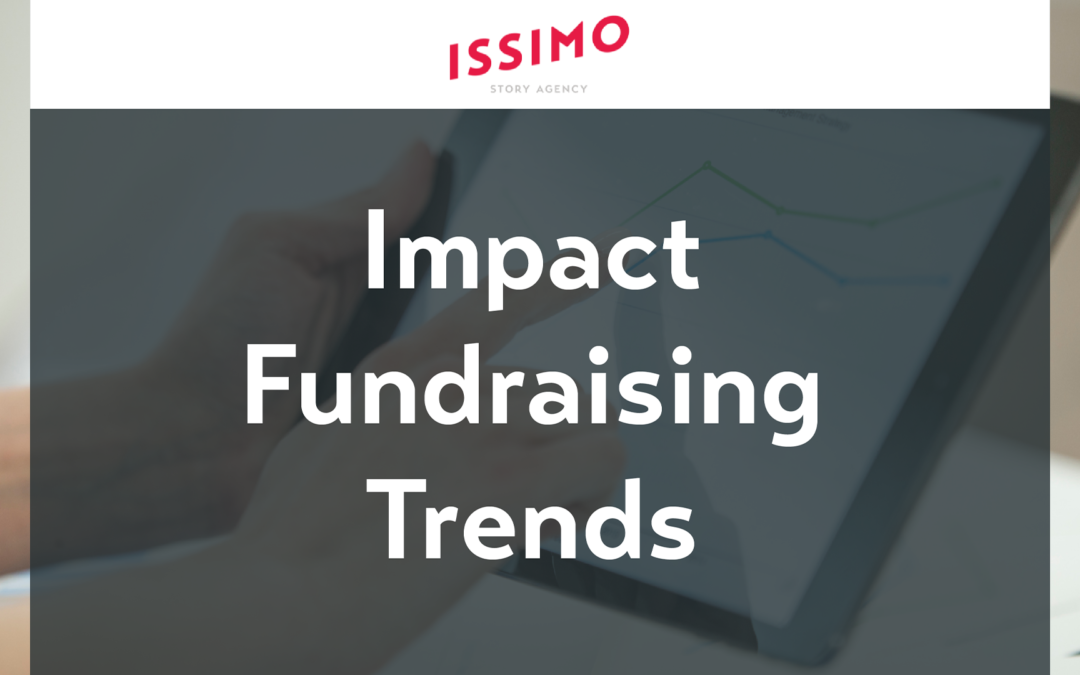Trends in Impact Fundraising
The financial industry is a crowded field and the same holds true for impact fundraising. Each firm discovers what works for them, and they keep that information top secret. However, in order to shift capital flows toward impact, we need to work together.
We believe collaboration is essential for those in the impact space to succeed. That’s the spirit we at ISSIMO Story Agency had when we set out to conduct an attitudinal research study, which looked at peer-based best practices in impact fundraising.
Our previous post discussed the three attitudinal segments we discovered in the data and two “secret sauce” elements to successful fundraising.
In this post, we’ll explore how and where your peers are raising capital and what you can learn from these impact fundraising trends.
Different Segments, Different Ways to Raise Funds
Three distinct segments emerged from the data: Confident, Aspiring, and Struggling respondents. They each have differing perspectives, activities, and success levels.
We found that Aspiring respondents are significantly more likely than other segments to say they raise funds from individual investors, corporations, foundations, grants, and public funds. Confident respondents are more likely than other segments to source funds through asset management firms. Here are some interesting statistics we discovered regardless of segment:
- 72 percent have an in-house fundraising team
- 48 percent use an online fundraising platform
- Less than 25 percent use either a crowd-sourced fundraising platform, a third-party database, or an outsourced fundraising team
Organizations in this space rely so heavily on fundraising, but it also requires a great deal of trust, both from potential investors and donors as well as management trusting their fundraising team internally (and the vast majority keep that role in-house). Most use traditional networking with personal and face-to-face interactions to find potential investors. The larger the check size and the more institutional the investor, the more that traditional avenues are going to remain relevant.
With digital resources growing, building trust is still important, and perhaps even more so to overcome the digital divide. Virtually, establishing thought leadership and having proxies for trust (ie., things that build credibility such as third-party validation and brand, publication, or partner logos) have become even more essential. We predict things like digital platforms and databases and outsourced fundraising teams will become even more relevant in the future, and impact fundraisers are going to need to leverage them with effective storytelling in order to be successful.
Finding Investors When Fundraising for Impact
When it comes to how firms find investors, 69% use personal connections of their senior leaders. In fact, it’s the most identified source among those we listed with 79 percent of Aspiring, 67 percent of Struggling, and 62 percent of Confident respondents citing this source to get potential investors. Some other interesting statistics:
- Half of our respondents say they find investors by conducting research into people who have funded organizations similar to theirs.
- Aspiring respondents are the least likely of the segments to say they’ve hired placement agents or other third-party groups to make introductions to qualified investors—only 5 percent have done this compared to at least 25 percent of respondents in the Confident and Struggling segments.
Even in a digital age, it’s still important to have a personal network. Conference attendees make up 36 percent of potential investors, the third-highest source.
The downside is that a partner’s direct network can be hard to scale. Nothing beats a strong personal connection. However, thought leadership (and amplifying partners’ expertise to a broader audience) is a way to amplify those connections and build trust. Although it’s not easy or fast, it’s a consistent investment that pays off over time. The majority of fundraising is done reactively and not often connected with long-term initiatives, even when the need for fundraising is not a one-time occurrence.
Events Are Keys to Success
Getting out there and attending events is a common way for organizations to gain fundraising insights with most respondents saying their organization sends representatives to attend fundraising-specific events or conferences. Around 22 percent of all respondents say they do so often, and 39 percent say they do so sometimes.
However, when asked how often someone from their organization speaks at conferences, Confident and Aspiring respondents are more likely than Struggling respondents to say it happens often or sometimes. 72 percent of Confident and 80 percent of Aspiring respondents say it happens at least sometimes, while 42 percent of Struggling respondents say it happens rarely or never.
Speaking opportunities at conferences are often offered to those with a reputation as an expert, which Confident and Aspiring respondents are more likely to say their organizations have. 69 percent of Confident respondents and 57 percent of Aspiring respondents strongly agree that their organization has a reputation for being a thought leader, compared to only 33 percent of Struggling respondents. And Confident respondents are far more likely than those in the other segments to say their organization’s founder or leader has a thought leadership reputation. 75 percent of Confident respondents strongly agree with this statement, compared to only 40 percent of Aspiring and Struggling respondents.
Struggling respondents are also the least likely to say their organization sponsors conferences—38 percent of these respondents say it never happens. 20 percent of Confident respondents say it happens often, and 31 percent say it happens sometimes.
It seems that events are still relevant, both for building personal networks as well as establishing thought leadership via speaking and sponsorship opportunities, especially in front of the right audience. Donors tend to extend more trust to people with expertise and endorsements because they are perceived as being a subject matter expert, whereas just having a booth, sponsoring the event, or handing out business cards is perceived as a pay-to-play situation without the third-party validation.
In an increasingly crowded impact space where so many people are jumping on the bandwagon, it is even more essential to differentiate your organization through thought leadership. In a world that’s becoming more digital, impact fundraising trends show that more trust is needed to be successful.
To learn more about each segments’ behaviors and the opportunities they present, check out our entire executive summary. And to explore the data yourself, check it out here.

